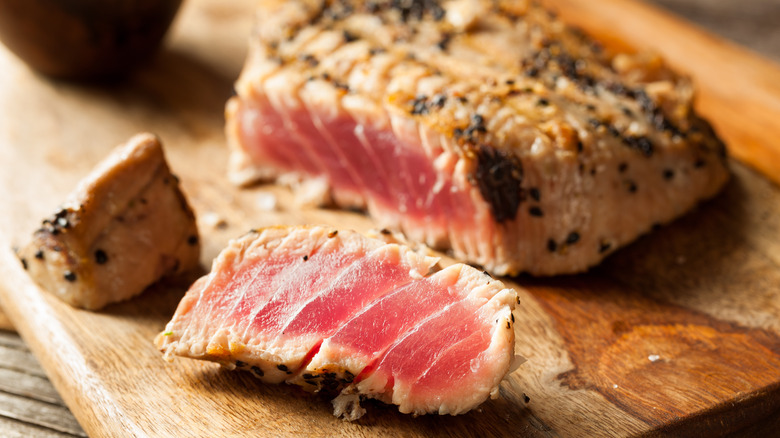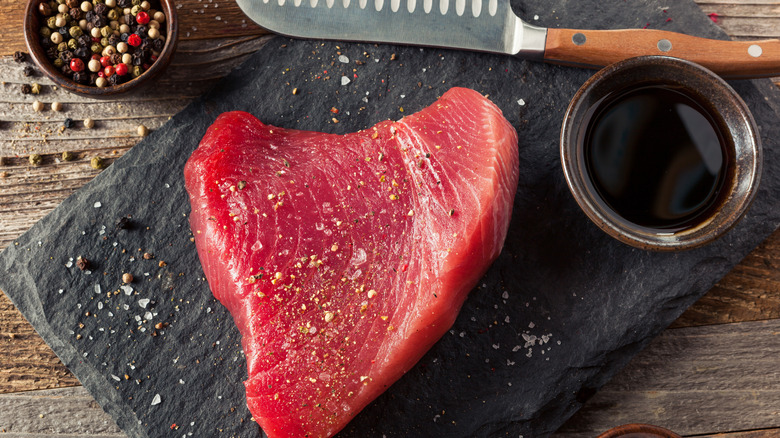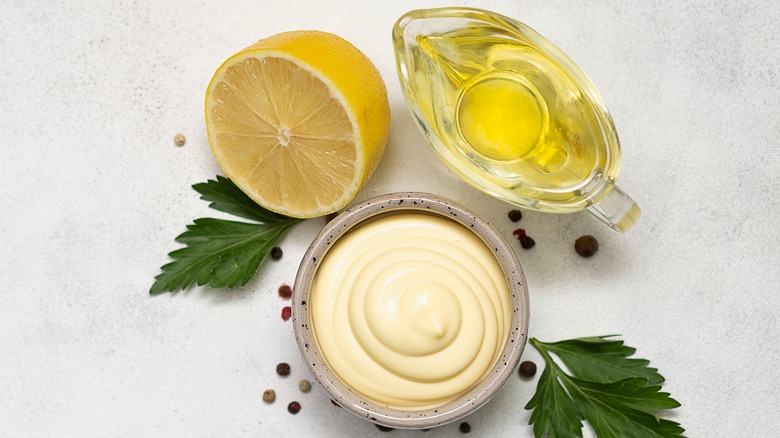Mayonnaise Is The Secret To Unbelievably Moist Tuna Steaks
A well-cooked piece of tuna makes for a luxurious and delicious meal. Ideally, it should have a nicely browned exterior with a moist, tender interior. Whether you're cooking coriander-seared tuna with an ultra-rare center, or firing up some charcoal for grilled tuna sandwiches, the goal is the same. You want to maximize flavor without overcooking the tuna.
The problem here is that tuna is a lean, delicate protein prone to overcooking. Leave a tuna steak on the grill for a bit too long, and you'll go from succulent to chalky before you know it. Tuna also has a tendency to cling to the grates, and while there are plenty of ways to keep fish from sticking to the grill, one of the easiest ways is to coat your tuna in mayonnaise. Yes, you read that correctly: mayonnaise.
Mayo actually has many applications beyond keeping your sandwich moist or coating your chicken salad. In fact, mayo is a triple threat when it comes to cooking tuna. It can insulate the tuna, help it cook more gently, and allow the fish to brown beautifully.
Balancing flavor and cooking time
Grilling, searing, or broiling a piece of tuna is essentially a race against time. You want to cook the fish long enough to develop some delicious browning on the exterior, but not so long that you dry out the tuna.
Mayonnaise helps on both fronts. By coating your tuna in mayo, you create a fatty layer of insulation between the tuna and the heat source. Think about how the batter on a piece of fried chicken prevents the chicken from overcooking. That's what the mayonnaise is doing here. It creates a wall between the heat and the protein. This gives you a greater margin of error when it's time to remove your fish from the heat.
Mayo also has the added benefit of making food brown swiftly. This is because oil and eggs are the primary ingredients of mayo, giving it a relatively high-fat content. As food cooks and its fat breaks down, the Maillard reaction (the fancy word for the process of food browning) occurs. So not only does your tuna become easier to cook, but it gets tastier too. If you're worried about your tuna tasting like the deli aisle, fear not. The final product won't taste like mayo, as it will mostly be cooked off.
Jazz mayo up with a sauce or spices
You can coat your tuna in mayo for a variety of different cooking techniques. It performs well for grilling, searing, and broiling. This gives you plenty of freedom to adapt the technique to different styles of meals.
Because mayo has a fairly mild flavor, it creates a blank canvas that you can make your own. Want to take your tuna in a more Mediterranean direction? Try coating it with pesto mayo. Or you can mix your mayo with sriracha and a touch of soy for a spicy tuna roll-inspired meal. This is a perfect place to roll up your sleeves and experiment. Want a South American feel? Throw in some chimichurri. Make something custom by adding in your favorite spices and fresh herbs — parsley, dill, and a sprinkle of chives pair beautifully with hearty tuna.
You can also treat your zhuzhed-up mayo like a marinade. Just coat your meat in advance and let it sit in the refrigerator for a few hours. This will allow the flavors to be incorporated even further. Finally, this technique works on many kinds of food. Try it on other kinds of fish like salmon, or even on grilled vegetables. For such a humble condiment, it turns out that mayo can do some heavy lifting.



